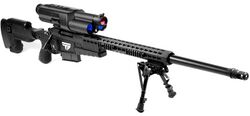Company:TrackingPoint
| Type | Private |
|---|---|
| Industry | Applied technology |
| Founded | Script error: No such module "Date time". |
| Founder | John McHale |
| Headquarters | , |
| Website | tracking-point.com |
TrackingPoint is an applied technology company based in Austin, Texas . In 2011, it created a long-range rifle system that was the first precision guided firearm.[1][2]
Formed by John McHale in February 2011, the company created its first PGF prototype in March 2011. The company offered its first product in January 2013[3] and a second, the AR Series semi-automatic smart rifle, in January 2014.[4]
Variants of the company's bolt-action rifles use .338 Lapua Magnum and .300 Winchester Magnum ammunition. Semi-automatic variants are available in 7.62 NATO, 5.56 NATO and .300 BLK.
In September 2016, the company began selling the M1400, a squad-level .338 Lapua bolt-action rifle that can hit targets out to 1,400 yards (1,280 m). It can also acquire and hit targets traveling at 20 mph (32 km/h) within 2.5 seconds. The rifle is 45 in (110 cm) long with a 22 in (560 mm) barrel, weighing 15.4 lb (7.0 kg). It can be used with the company's ShotGlass wearable glasses that transmits what the scope is seeing to the shooter's eye.[5][6]
In January 2014, the U.S. Army purchased six TrackingPoint fire control systems to begin exploring purported key target acquisition and aiming technologies.[7] The Army has integrated the system onto the XM2010 Enhanced Sniper Rifle for military testing.[8]
In 2018, TrackingPoint introduced the ShadowTrak 6 bolt-action rifle with 6.5 mm Creedmoor cartridge that can hit targets out to 1,000 yards (914 m), and can hit targets traveling at 20 mph (32 km/h) in 1 second. Weighing 14.6 lb (6.6 kg), it can fire Hornady ammunition; the 147gr ELD-M (a match type bullet) or the 143gr ELD-X (designed for hunting).[citation needed]
In November 2018, Talon Precision Optics, of Jacksonville, Florida, bought TrackingPoint.[9]
Technology


TrackingPoint's precision guided firearms system uses several component technologies:
- Networked Tracking Scope: The core engine that tracks the target, calculates range and the ballistic solution, and works in concert with the shooter and guided trigger to release the shot.[10][11]
- Barrel Reference System: A fixed reference point that enables the networked tracking scope to make adjustments and retain zero over time. The barrel reference system is factory calibrated to a laser reference.[12]
- Guided to Trigger: The rifle's trigger is hard-wired to the networked tracking scope. The networked tracking scope controls the trigger weight to eliminate trigger squeeze and shot timing errors.[13]
- Field Software Upgradeable: Software can be uploaded to the scope to add capability.[14]
- Heads Up Display (HUD): The HUD indicates range, wind, reticle, video storage gauge, zoom, and battery life, plus LRF icon, Wi-Fi on/off icon, compass icon, can't wheel, inclination wheels and off-screen indicators.[10][15]
- Recording: An integrated camera captures video and still images from the networked tracking scope and heads up display. Recorded images can be downloaded to a smartphone or tablet from the scope and transmitted via email or social media.[16]
Vulnerabilities
In 2017, computer security experts Runa Sandvik and Michael Auger demonstrated that naive software design left the rifle's aiming computer open to remote hacking when its Wi-Fi capability was turned on. They showed that third parties could alter operating parameters; for example, making the computer think the bullet weighed from 0.4 ounces (11 g) to 72 pounds (33 kg), which would make the rifle fire inaccurately. A skilled hacker could acquire root access and brick the computer.[17]
References
- ↑ Rothman, Wilson (Jan. 10, 2013). “Futuristic Rifle Turns Novice Into Sharpshooter.” NBC News. Retrieved Jan. 20, 2013.
- ↑ Murphy, Samantha (Jan. 11, 2013). “TrackingPoint is World’s First Smart Hunting Rifle.” Mashable. Retrieved Jan. 20, 2013.
- ↑ “The TrackingPoint Story.” TrackingPoint website. Retrieved Jan. 20, 2013.
- ↑ "TrackingPoint Announces New AR Series Rifles" TrackingPoint website. Retrieved March 4, 2014.
- ↑ Tracking Point’s New Squad-Level Rifle - Kitup.Military.com, 20 April 2016
- ↑ TrackingPoint reveals the M1400 precision-guided firearm - Armyrecognition.com, 22 April 2016
- ↑ "Army Testing TrackingPoint Smart-Rifle Tech" - Kitup.Military.com, 27 January 2014
- ↑ Army Testing Smart Scope on .300 Win Mag Sniper Rifle - Kitup.Military.com, 14 March 2014
- ↑ Optics, Talon Precision. "Talon Precision Optics, LLC Announces Asset Purchase in Precision-Guided Firearms and Advanced Optics Technologies". www.prnewswire.com (Press release). Retrieved 2021-05-01.
- ↑ 10.0 10.1 Takahashi, Dean (Jan. 13, 2013). “TrackingPoint’s Wi-Fi Networked Sniper Scope Can Lock on Targets From Afar and Stream Gun Sight Video.” VentureBeat. Retrieved Jan. 20, 2013.
- ↑ Wawro, Alex (Jan. 9, 2013). “The Hunting Rifle of the Future is Here at CES.” PC World. Retrieved Jan. 20, 2013.
- ↑ Barrell Reference System. TrackingPoint website. Retrieved Jan. 20, 2013.
- ↑ Hutchinson, Lee (Jan. 9, 2013). “$17,000 Linux-Powered Rifle Brings ‘Auto-Aim’ to the Real World.” Ars Technica. Retrieved Jan. 20, 2013.
- ↑ Higgins, Kilroy (Jan. 9, 2013). “TrackingPoint Shows Off Auto-Aiming Rifle.” Bright Side of News. Retrieved Jan. 20, 2013.
- ↑ Curtis, Rob (Jan. 14, 2013). “TrackingPoint Can Turn Your Grammy Into a Deadly Marksman.” Military Times GearScout. Retrieved Jan. 20, 2013.
- ↑ Dillow, Clay (Jan. 10, 2013). “The 'Intelligent' Rifle, Now With iPad App, Wi-Fi, Infallible Accuracy.” Popular Science. Retrieved Jan. 20, 2013.
- ↑ Andy Greenberg (2017-07-29). "Hackers Can Disable a Sniper Rifle—Or Change Its Target". Wired magazine. https://www.wired.com/2015/07/hackers-can-disable-sniper-rifleor-change-target/. Retrieved 2018-07-27. "The married hacker couple have developed a set of techniques that could allow an attacker to compromise the rifle via its Wi-Fi connection and exploit vulnerabilities in its software."
External links
- TrackingPoint website.
- "Military Science Inspires Better Rifle Control". February 9, 2014. http://science.dodlive.mil/2014/02/09/military-science-inspires-better-rifle-control/.
- "Sniper Weapon Fire Control Error Budget Analysis". United States Army Research Laboratory. August 1999. http://www.arl.army.mil/arlreports/1999/ARL-TR-2065.pdf.
